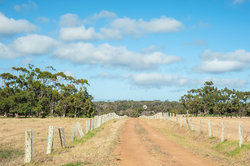 Farm Fencing experts and hobby ranchers from Colorado, Carol Ekarius and her husband, Ken Woodard, wrote an article a few years back for Hobby Magazine. It discusses in a good amount of detail about building a fence for your farm. “Farm fencing is a big expense, both in terms of time and money, but it's one of the most important purchases a farmer will make, and it’s best made early in the process of setting up your farm,” according to Carol and Ken. Without the right type of fencing for your farm, you could either be spending a lot of money on upkeep, or on recovering lost animals! Here are a few of the highlights from the article:
Farm Fencing experts and hobby ranchers from Colorado, Carol Ekarius and her husband, Ken Woodard, wrote an article a few years back for Hobby Magazine. It discusses in a good amount of detail about building a fence for your farm. “Farm fencing is a big expense, both in terms of time and money, but it's one of the most important purchases a farmer will make, and it’s best made early in the process of setting up your farm,” according to Carol and Ken. Without the right type of fencing for your farm, you could either be spending a lot of money on upkeep, or on recovering lost animals! Here are a few of the highlights from the article:
Fence Laws and Regulations:
Every state has laws that regulate ownership and control of livestock. In some areas where “free-range” laws are still enforced, a landowner must fence out the neighbor’s animals, but in most places, it is the livestock owner’s responsibility to control his or her animals with adequate livestock fences.
Fence laws typically define who is responsible for constructing and maintaining a fence, who has liability when animals get out and cause damage (including when they get on the road and cause an accident), and a description of what constitutes a “legal fence.”
Some local governments also have fence laws, which often prohibit the use of certain types of fence. Your County Extension Agent or local animal control officer should be able to provide information on the fence law in your area.
Your Existing Fence: Fix or Replace?
If you’ve inherited an old fence, you’re faced with the dilemma of fixing it up or replacing it. Some old fences still have lots of life left in them, and with just a minor amount of repairs can provide years of service. But many are more trouble than they’re worth.
To decide which category your fence falls into, take a stroll. Walk the entire fence slowly and look at its condition. Are posts rotting and falling over? Push them with all your strength; do they move easily? Are wires rusted to the point that it takes little pressure to break them? If you answer yes to these questions, scrap the existing fence. On the other hand, if the posts are still stout and firm and wires aren’t severely rusted, or if there are just one or two spots that are failing, you might be able to just tighten up an existing fence.
Map Out Farm Fencing
Before you start purchasing materials, it helps to map out your fencing project. Draw your farm on grid paper showing roads, buildings, paddocks and significant natural features, such as heavy woods, ponds and rock outcroppings.
Paddock Design
Having multiple paddocks (pasture subdivisions) to rotate livestock through improves grass management, feed quality and herd health. The more paddocks the better, but ultimately, aim for at least eight.
Gate Placement
Gates are best constructed at the onset, and extra gates provide greater flexibility, but they also cost extra money. Plan gate layout for ease of movement, both for animals and equipment that might need to pass through. Man gates should be 4 feet wide, and equipment gates should be 12 to 16 feet wide. Show property lines, paddock lines and gates on your map. Take measurements for the lines, and mark them accordingly.
Guidelines for Fence Posts
While the type of post you choose depends on the type of fencing you ultimately select, there are some general guidelines:
• Posts should be stout with about one third buried.
• 8 to 12 feet between posts is the usual spacing recommendation.
• PVC posts generally require more concrete.
• Standard metal “T” posts fit with PVC sleeves reduce impalement risks.
• Wood posts should be treated with a preservative before being put in the ground. Peeling the bark is also recommended as it can harbor boring insects and trap moisture, which hastens decay.
Don’t Forget the Fasteners
Choosing the Right Fence Stapling System
The BECK Fence Stapling System is the perfect balance of superior holding strength and superior corrosion resistance. And with the added benefit of using a pneumatic stapler for ease and speed, we ensure your large wire fencing jobs are done with both the quality you need and the efficiency you require.
.svg.png)

